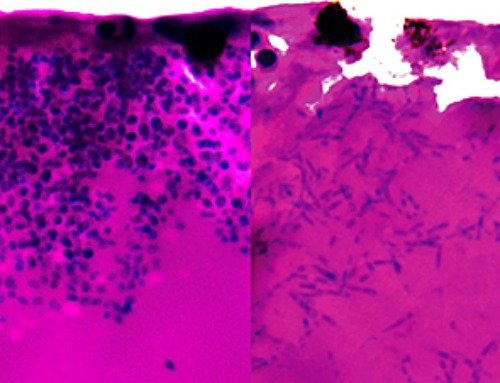Scientists at the University of Illinois Urbana-Champaign have developed a portable, self-powered ultraviolet-C device called the Tribo-sanitizer that can inactivate two of the bacteria responsible for many foodborne illnesses and deaths.
The bacteria selected as testing targets are two of the most common causes of serious foodborne illness outbreaks in the U.S. Escherichia coli produces toxins that can cause severe abdominal cramps, fever, bloody diarrhea, and kidney failure, and Listeria monocytogenes can cause listeriosis, which has the highest rates of hospitalization and mortality of any foodborne illness.
The team assessed the Tribo-sanitizer’s decontamination capability with bacteria in liquids and on three solids—fresh apple peels, romaine lettuce, and polyethylene terephthalate, commonly known as PET, a popular material for food and beverage packaging.
The results indicated that the Tribo-sanitizer had strong potential to meet the Food and Drug Administration’s sanitization standards. Specifically, the device “achieved reductions of at least 99.999% on the E. coli strain in buffer solution and on PET, demonstrating the Tribo-sanitizer’s excellent decontamination ability,” said corresponding author Yi-Cheng Wang, a professor of food safety and engineering.
On produce, the device achieved smaller but still useful reductions of about 99.98% for the E. coli bacteria 99.9% for L. monocytogenes on the apple peels, and 99.8% for E. coli and 98% for L. monocytogenes on romaine lettuce, according to the paper.
These outcomes “are comparable to those reported in other studies that utilized UV light with a commercial power source for the decontamination of fresh produce,” said doctoral student Zachary (Zhenhui) Jin, who was the co-first author of the paper with alumnus Fujunzhu Zhao. Graduate student Longwen Li also participated in the study.
While light-based technologies like Tribo-sanitizer’s lamp “can be very effective when surfaces are directly exposed to the light source,” Wang said they may not adequately decontaminate areas that are not directly illuminated, such as uneven or rough surfaces on lettuces and apple peels.
“This could be addressed by incorporating other decontamination methods or using multiple light sources at different angles,” he said. “That is one of the future directions we are working on. And if properly incorporated into existing facilities such as transportation or storage units, the Tribo-sanitizer could potentially provide continuous decontamination throughout the supply chain without the need for commercial power.”
Although the length of time needed to achieve a 99.999% reduction in E. coli bacteria was long—currently 90 minutes—Jin said that the device’s potential to achieve continuous decontamination, such as within trucks on the highway, means that this extended time should not be seen as a major drawback. The team is continuing its efforts to improve the Tribo-sanitizer, and “this time can be expected to be much shorter in the future,” he said.
According to the World Health Organization, foodborne illness affects almost 600 million people annually, resulting in 420,000 deaths. The economic cost of dealing with the consequences of food contamination is more than $15.6 billion per year in the U.S. and $110 billion in low- and middle-income countries, according to estimates by the U.S. Department of Agriculture and the WHO, respectively. Wang said that the Tribo-sanitizer represents a novel means of alleviating these problems.
Consumers could use Tribo-sanitizers at home to sanitize surfaces, foods, and more because “the estimated cost of the materials used to build the device is less than $70,” Jin said.
The device’s self-powered character also gives it “excellent potential for use in low-resource settings such as natural disaster areas and conflict zones where electricity is absent or unreliable,” Li said.
More information: Zhenhui Jin et al, Tribo-sanitizer: A portable and self-powered UV device for enhancing food safety, Nano Energy (2023). DOI: 10.1016/j.nanoen.2023.108675
News
Scientists Unlock a New Way to Hear the Brain’s Hidden Language
Scientists can finally hear the brain’s quietest messages—unlocking the hidden code behind how neurons think, decide, and remember. Scientists have created a new protein that can capture the incoming chemical signals received by brain [...]
Does being infected or vaccinated first influence COVID-19 immunity?
A new study analyzing the immune response to COVID-19 in a Catalan cohort of health workers sheds light on an important question: does it matter whether a person was first infected or first vaccinated? [...]
We May Never Know if AI Is Conscious, Says Cambridge Philosopher
As claims about conscious AI grow louder, a Cambridge philosopher argues that we lack the evidence to know whether machines can truly be conscious, let alone morally significant. A philosopher at the University of [...]
AI Helped Scientists Stop a Virus With One Tiny Change
Using AI, researchers identified one tiny molecular interaction that viruses need to infect cells. Disrupting it stopped the virus before infection could begin. Washington State University scientists have uncovered a method to interfere with a key [...]
Deadly Hospital Fungus May Finally Have a Weakness
A deadly, drug-resistant hospital fungus may finally have a weakness—and scientists think they’ve found it. Researchers have identified a genetic process that could open the door to new treatments for a dangerous fungal infection [...]
Fever-Proof Bird Flu Variant Could Fuel the Next Pandemic
Bird flu viruses present a significant risk to humans because they can continue replicating at temperatures higher than a typical fever. Fever is one of the body’s main tools for slowing or stopping viral [...]
What could the future of nanoscience look like?
Society has a lot to thank for nanoscience. From improved health monitoring to reducing the size of electronics, scientists’ ability to delve deeper and better understand chemistry at the nanoscale has opened up numerous [...]
Scientists Melt Cancer’s Hidden “Power Hubs” and Stop Tumor Growth
Researchers discovered that in a rare kidney cancer, RNA builds droplet-like hubs that act as growth control centers inside tumor cells. By engineering a molecular switch to dissolve these hubs, they were able to halt cancer [...]
Platelet-inspired nanoparticles could improve treatment of inflammatory diseases
Scientists have developed platelet-inspired nanoparticles that deliver anti-inflammatory drugs directly to brain-computer interface implants, doubling their effectiveness. Scientists have found a way to improve the performance of brain-computer interface (BCI) electrodes by delivering anti-inflammatory drugs directly [...]
After 150 years, a new chapter in cancer therapy is finally beginning
For decades, researchers have been looking for ways to destroy cancer cells in a targeted manner without further weakening the body. But for many patients whose immune system is severely impaired by chemotherapy or radiation, [...]
Older chemical libraries show promise for fighting resistant strains of COVID-19 virus
SARS‑CoV‑2, the virus that causes COVID-19, continues to mutate, with some newer strains becoming less responsive to current antiviral treatments like Paxlovid. Now, University of California San Diego scientists and an international team of [...]
Lower doses of immunotherapy for skin cancer give better results, study suggests
According to a new study, lower doses of approved immunotherapy for malignant melanoma can give better results against tumors, while reducing side effects. This is reported by researchers at Karolinska Institutet in the Journal of the National [...]
Researchers highlight five pathways through which microplastics can harm the brain
Microplastics could be fueling neurodegenerative diseases like Alzheimer's and Parkinson's, with a new study highlighting five ways microplastics can trigger inflammation and damage in the brain. More than 57 million people live with dementia, [...]
Tiny Metal Nanodots Obliterate Cancer Cells While Largely Sparing Healthy Tissue
Scientists have developed tiny metal-oxide particles that push cancer cells past their stress limits while sparing healthy tissue. An international team led by RMIT University has developed tiny particles called nanodots, crafted from a metallic compound, [...]
Gold Nanoclusters Could Supercharge Quantum Computers
Researchers found that gold “super atoms” can behave like the atoms in top-tier quantum systems—only far easier to scale. These tiny clusters can be customized at the molecular level, offering a powerful, tunable foundation [...]
A single shot of HPV vaccine may be enough to fight cervical cancer, study finds
WASHINGTON -- A single HPV vaccination appears just as effective as two doses at preventing the viral infection that causes cervical cancer, researchers reported Wednesday. HPV, or human papillomavirus, is very common and spread [...]





















